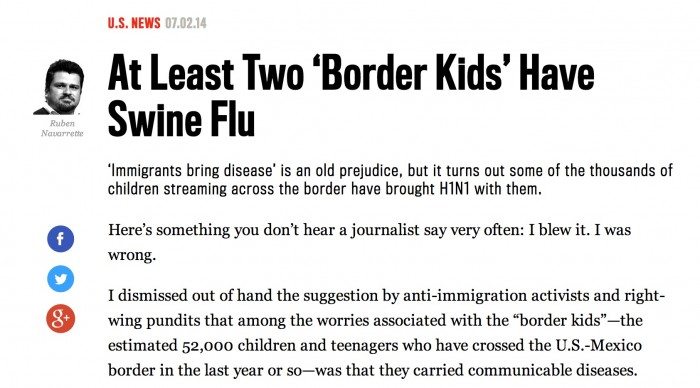I am starting to wonder if we are living in 2014 or whether it’s 1902 or 1857 because all of sudden the paranoia of unaccompanied minors invading the United States with plague, pestilence and illness is beginning to dominate the comments of people like this woman (yes, an actual photo from Monday’s shameful Murrieta protests):
That is what some parts of the media want you to believe. Case in point, there has been “breaking news” in the last few days that one or two minors in Texas were diagnosed with “swine flu,” also known as H1N1. The Blaze. Breitbart. Local FOX News. The Daily Beast’s Ruben Navarrette. By the way, Navarrette even apologized from dropping the ball since he now admits that some of these “border kids” (what are they, a pop group?) are bringing communicable diseases into this country:
Navarrette then wrote this:
Now, sure enough, that once inconceivable nightmare scenario that we were all afraid to ponder could be one step closer to coming true. The culprit: H1N1, more commonly known as “swine flu.”
The U.S. Department of Health and Human Services recently [sic] that an unaccompanied minor from Central America has the H1N1 flu. The minor, who entered the country in the last few months, had recently been—along with 1,000 other border kids—relocated to Lackland Air Force base in San Antonio.
Meanwhile, a source close to the situation on the border told me on June 21 that there was a confirmed case of a child having the H1N1 virus. He spoke on condition of anonymity so he could relay the information candidly, given the sensitivity of the subject matter and the possibility of sparking a public panic.
Then there is this:
Now H1N1 may be back. It has been delivered into our air supply by unsuspecting pint-sized carriers who have endured a lot of pain, sacrifice and suffering to get here and whose fate is still unclear.
Sounds scary, right?
Problem is: it’s not real journalism.
What surprises me from all these stories is that not one writer or editor even bothered to check the fact that early this year the H1N1 virus was already here (The Blaze makes a small reference to an “uptick”.) In a January 2014 story from USA Today, we see this:
This year the predominant flu strain in the United States is H1N1, the same one that caused the international pandemic in 2009-2010. The CDC estimates that 284,000 people died worldwide during that flu season.
“Based on what we’re seeing so far, this year will be a very different picture than last year,” said Michael Osterholm, director of the Center for Infectious Disease Research and Policy at the University of Minnesota in Minneapolis.
In 2012-2013, H3N2 was the dominant flu strain. It tended to cause serious illness and deaths in older people. With H1N1 the main strain this year, “we fully expect to see many more cases in younger children and middle-aged adults,” Osterholm said.
“Mark my word, by the end of next week we’ll probably see some fear and panic as it starts to hit kids,” he said.
This year’s flu vaccine contains the H1N1 strain and should offer good protection. There’s still time to get vaccinated and protect yourself and your family, Bresee said.
“It’s too early to tell how severe it’s going to be but we’re still on the up slope of the flu season, so what we can expect is more flu, more intense disease and more deaths over the next few weeks,” Bresee said.
The H1N1 strain has not had time to develop much resistance to antiviral drugs such as Tamiflu. People who are sick, especially if they’re in a high risk group, should see their doctor if they suspect they have the flu so they can be treated, he said.
That includes the very young and the very old as well as people with chronic medical conditions such as asthma, diabetes and congestive heart failure. Studies show the drugs work best when begun within two days of getting sick but they can still be helpful if started later for those in high risk groups.
Some “uptick.”
So let me get this straight: two minors from Central American are bringing a deadly flu virus into a country that already has the virus? A little context would have gone a long way in reporting a bit more truth to all this, but hey, immigrants are now bringing diseases to the county. Here’s a crazy thought: what if the H1N1 strain got on a plane from, I don’t know, Dallas to Honduras or El Salvador? Do we know for a fact that H1N1 originated from Central America? The USA Today story would suggest otherwise. But in case you need more, some actual 2009 data (2009, people) from the Center for Disease Control: “CDC estimates that from April to January 16, 2010, approximately 57 million cases of 2009 H1N1 occurred in the United States, including 257,000 H1N1-related hospitalizations and about 11,690 deaths.”
And then there is this from the CDC:
Where did the 2009 H1N1 flu virus come from?
The 2009 H1N1 influenza virus (referred to as “swine flu” early on) was first detected in people in the United States in April 2009. This virus was originally referred to as “swine flu” because laboratory testing showed that its gene segments were similar to influenza viruses that were most recently identified in and known to circulate among pigs. CDC believes that this virus resulted from reassortment, a process through which two or more influenza viruses can swap genetic information by infecting a single human or animal host. When reassortment does occur, the virus that emerges will have some gene segments from each of the infecting parent viruses and may have different characteristics than either of the parental viruses, just as children may exhibit unique characteristics that are like both of their parents. In this case, the reassortment appears most likely to have occurred between influenza viruses circulating in North American pig herds and among Eurasian pig herds. Reassortment of influenza viruses can result in abrupt, major changes in influenza viruses, also known as “antigenic shift.” When shift happens, most people have little or no protection against the new influenza virus that results.
Yeah, two kids from Central America in 2014 are the cause for a virus that has been affecting millions of Americans for the last five or six years.
Why does anyone not fact-check anymore?
Because if reporters and editors actually did, they wouldn’t have a narrative to scare you. This week’s message: Disease-Ridden Children! Threat to National Security! Let’s run with that!
Here’s another example: a report last night from local San Diego media (note the fact that no one else in this “report” was interviewed):
SAN DIEGO – A Border Patrol agents union representative told 10News the influx of undocumented immigrants now in Border Patrol custody is threatening the health of agents as well as national security.
“We have compassion for them …,” said union representative Ron Zermeno.
At about 12:45 a.m. Wednesday, one of the buses pulled out of the checkpoint and onto a freeway. Two people sitting behind the driver appeared to be Border Patrol agents wearing masks. 10News could not confirm if any children were on the bus. As 10News was trying to follow the bus onto a freeway, Border Patrol SUVs blocked the entrance to the freeway.
Zermeno told 10News Wednesday morning that 99 migrants were transported to various San Diego Sector Border Patrol stations for processing. According to Zermeno, 40 had been taken to Brown Field Station in Otay Mesa. Forty-two were taken to the Imperial Beach Station, and 17 to the Boulevard Station in southeast San Diego County.
Zermeno said Border Patrol agents were being pulled off the line to help with processing the immigrants. Zermeno told 10News this could pose a safety issue due to less agents on the street.
Meanwhile, 40 were being quarantined at the Border Patrol Chula Vista Station with active scabies and head lice. The facility will provide them with showers, laundry service and bedding. Another 10 people, mostly children, were taken to local hospitals with unknown illnesses.
“That’s my biggest fear: their health and also safety in the field,” said Zermeno.
Cases of scabies and head lice now pose a national security risk to our country? If so, then we should shut down every public school in America. Listen, I know that these two diseases are contagious, but come on, the San Diego report could have linked to the CDC here and here. Both national-security-threatening diseases are treatable.
During a time where the immigration issue is getting more and more complex, those media outlets that at least TRY to present a fuller story should be applauded. Those who write about the flu, skin rashes and head lice and then conclude that the end of America is here, need to stop. Right now.
***
EDITOR’S NOTE: Julio (Julito) Ricardo Varela (@julito77) founded LatinoRebels.com in May, 2011 and proceeded to open it up to about 20 like-minded Rebeldes. His personal blog, juliorvarela.com, has been active since 2008 and is widely read in Puerto Rico and beyond. He pens columns on LR regularly. In the last two years, Julito represented the Rebeldes on CBS’ Face the Nation, NPR, Univision, and The New York Times. Recently, he was a digital producer for Al Jazeera America’s The Stream.





Solid. Good work on the fact-checking.
[…] predominant strain of flu in the U.S. with tens of thousands of cases reported already this year! Latino Rebels correctly pointed out millions of Americans have already had H1N1 swine […]